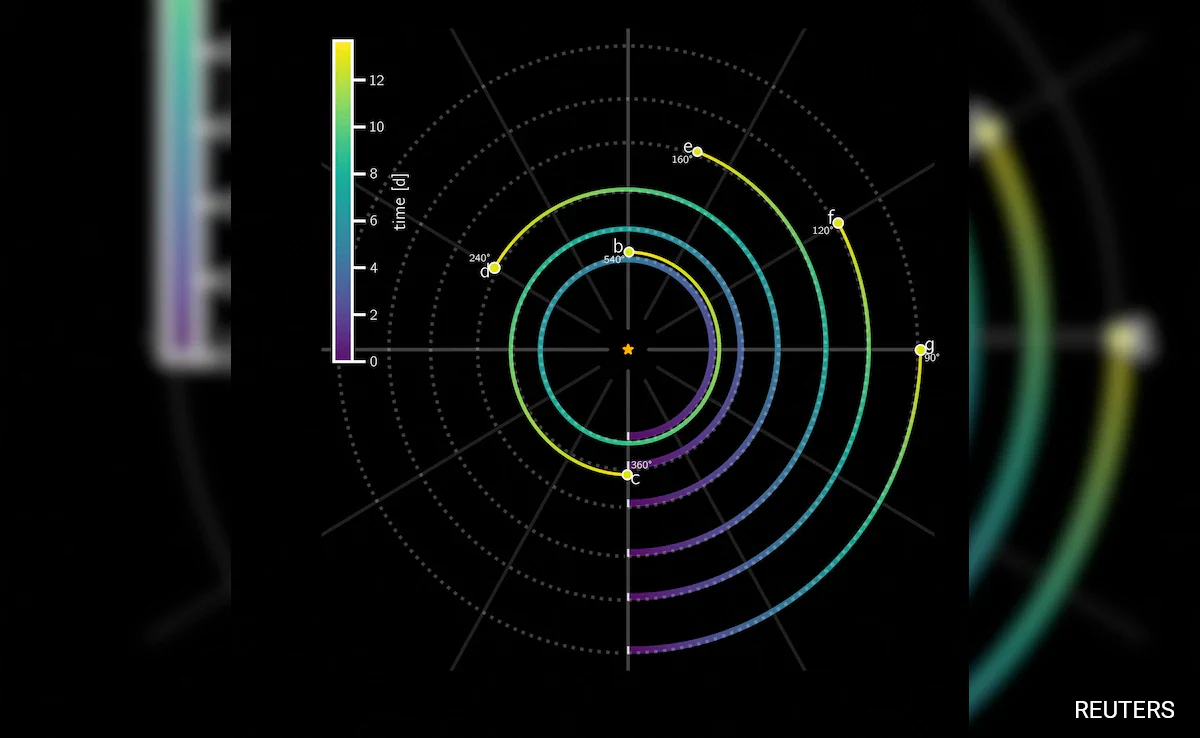Astronomers have discovered a unique system of six “sub-Neptune” planets in synchronized orbits around a star located approximately 100 light-years from Earth.

Astronomers have discovered a unique system of six “sub-Neptune” planets in synchronized orbits around a star located approximately 100 light-years from Earth.
These planets, two to three times the diameter of Earth but smaller than Neptune, orbit closer to their star than Mercury does to the sun, marking a significant development in the quest to understand the nature of these enigmatic celestial bodies.
The findings, published in the journal Nature and led by researchers from the University of Bern in Switzerland and the University of Chicago, reveal that these sub-Neptunes exhibit a rare condition known as orbital resonance. This implies that their synchronized orbits around the star have remained undisturbed for approximately 4 billion years, suggesting a lack of chaotic events, such as giant impact events, that could have perturbed their trajectories.
Six sub-Neptune exoplanets with radii ranging from 1.94R⊕ to 2.85R⊕ are found around the star HD 110067. Sub-Neptune can refer to a planet that has a radius less than Neptune but a mass bigger than Neptune, or it can refer to a planet that has a mass smaller than Neptune but a radius larger than Neptune, such as a super-puff. These definitions can even be used in the same publication.
The difference between sub-Neptunes (radii < 3 Earth radii) and Neptunes (radii > 3 Earth radii) is the radius-cliff. This radius-cliff is assumed to result from planets’ atmospheres reaching the pressures necessary to push hydrogen into the magma ocean during formation, while gas is accreting, stopping radius expansion. Then, radius increase can resume once the magma ocean saturates. Nevertheless, since they need a lot more gas, planets with enough gas to attain saturation are extremely unusual.
The fact that all six of those planets are in nearly perfect orbital resonance around HD 110067 is interesting. The star itself is somewhat bigger and has a mass similar to that of the Sun. This system’s discovery may offer important new information on planet formation.
Astronomer Hugh Osborn, one of the study’s authors, expressed excitement about the resonance aspect, citing the mathematical beauty of the phenomenon. He emphasized the potential of this system to unravel the mysteries surrounding sub-Neptune planets, a type prevalent in our Milky Way galaxy but absent from our solar system.
The unique aspect of this discovery lies in its ability to shed light on the composition and characteristics of sub-Neptunes. These planets, with diameters ranging from 1.9 to 2.9 times that of Earth, pose a scientific puzzle regarding their structure and atmospheric composition.
Rafael Luque, the lead author of the study, highlighted that scientists are actively researching whether sub-Neptunes are rocky planets with thick atmospheres of hydrogen and helium gas, planets made of rock and ice with warm and water-rich atmospheres, or something else entirely.
The sub-Neptunes discovered in this system possess a significant atmosphere, distinguishing them from Earth-like planets. The star around which they orbit, named HD110067, is about 20% smaller in mass than the sun and is visible in Earth’s night sky in the northern constellation Coma Berenices.
Observations of small dips in the star’s brightness, caused by the planets passing in front of it from our vantage point, facilitated the detection of these celestial bodies. The innermost planet completes an orbit around the star in approximately nine days, while the outermost planet takes around 54 days. Their orbits range between 6% and 20% of the distance between Earth and the sun.
Despite their intriguing characteristics, none of the sub-Neptunes fall within the nominal habitable zone for terrestrial planets. However, the researchers suggest that the habitable zone for sub-Neptunes may encompass a broader set of orbits due to their atmospheres, which could influence the planets’ surface temperatures.
Looking ahead, scientists are optimistic that the James Webb Space Telescope (JWST), operational since last year, will provide valuable insights into these sub-Neptune planets. The JWST is expected to contribute to ongoing research on the potential habitability of sub-Neptunes, offering promising results that could enhance our understanding of these mysterious celestial bodies.
In unraveling the secrets of synchronized sub-Neptunes, astronomers aim to broaden our comprehension of planetary systems and advance our knowledge of the vast cosmic tapestry that surrounds us.